Reef skeleton sediments contain a huge amount of environmental data for several thousand years, including annual records of ocean temperature, water pollution, and storm activity.
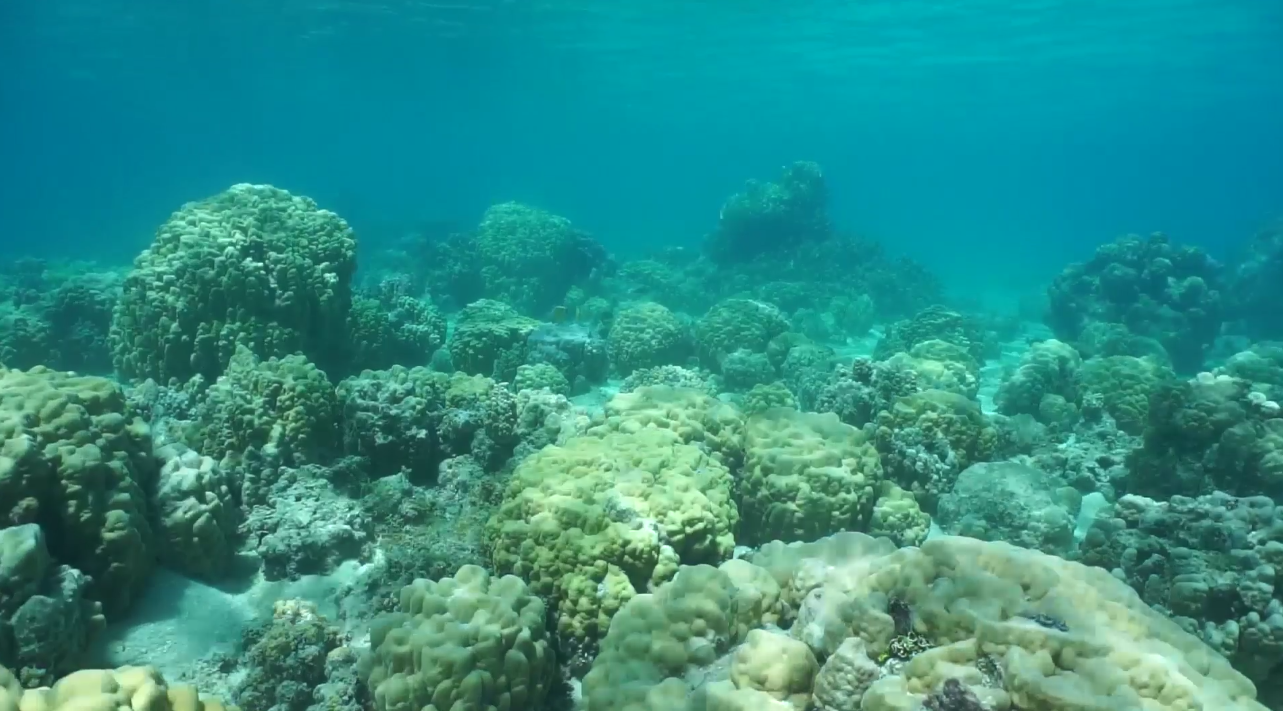 These massive lobed corals of the Porites lobata species grow in the lagoon of Huahine Island, French Polynesia. Core samples taken from reefs from corals from various places revealed information about the condition of the ocean a thousand years ago.
These massive lobed corals of the Porites lobata species grow in the lagoon of Huahine Island, French Polynesia. Core samples taken from reefs from corals from various places revealed information about the condition of the ocean a thousand years ago.When dusk sets in on the brilliant surface of the
Solomon Sea in the Pacific Ocean,
Guillaume Iwankow puts on his diving gear and descends from the research schooner Tara into a motorboat. His goal - to bring back the core, the test length from the arm, taken from a colony of
corals , the leading chronicle of the decades of her life.
After 10 minutes the boat leaves Tara, the motor slows down. It is so small here that the fish living on the reef flicker just a few centimeters from the surface. Ivankov, a specialist in scuba diving from the
Tara Expeditions Foundation , looks out for coral where you can take the largest and most ancient example of the Porites lobata — round, yellow-green corals that grow often so large that they are more like the contents of Godzilla's skull. Coral colonies are composed of soft animals,
coral polyps , which (using symbiotic algae) secrete the mineral calcium carbonate in thin layers. Over time, the annual layers accumulate one above the other and turn into a solid mass that makes up the skeleton of the coral.
 Guillaume Ivankov
Guillaume IvankovFinding perfect Porites, Ivankov presses his seven-centimeter core drill into the coral's surface. The drone with a quiet buzz sinks into the skeleton, and clouds of coral dust are released into the surrounding water. Penetrating through all the layers of coral, Ivankov tilts the drill here and there, tearing off the base of the cut sample, which is about 40 cm in length. He repeats this process in the same hole two more times, and then swims back and places the obtained samples in the boat - in the amount of about 120 cm in length. Only on the surface of the Porites formation are living polyps, so after drilling the coral should continue to grow in the shallows, without any damage or disturbance.
Such marine scientific expeditions collect all kinds of biological samples, from ocean water and fish living on reefs to microbes from corals. But coral cores are different. These are organic time capsules containing records of local pollution, geology, temperature, and reef health stretching back hundreds of thousands of years. Researchers continue to improve unexpected methods that can be used to extract such information from coral skeletons. Climatologists, geochemists and paleontologists who want to dive into the history of the ocean, are increasingly advised: study cores. “I call them natural reef history books,” said
Janice Law , a climatologist and coral core expert from the Australian Institute of the Sea. "They can tell a lot of stories."
Dive into ocean history
Coral core mining, as a detective investigation, has become a reliable way to enrich the theory of past events with details and proofs - or even simply to prove that these events have taken place. It is easy to forget that even before the 1970s, no one was sure that corals generally have annual rings. It was then that a team of geophysicists from the University of Hawaii visited
Eniwetok Atoll in the South Pacific.
Eniwetok was an unassuming island with an unusual history: the United States tested its nuclear weapons there in the 1940s and 50s. Researchers from Hawaii wondered if skeletons of growing corals demonstrate evidence of this radioactivity. If the coral layers contained radioactive elements with a known half-life, it would be possible to almost accurately calculate at what point which of the rings appeared. “They took a layer of a massive colony, put it on light-sensitive paper in a dark room for a month, and saw sets of radioactive strips,” said Low. The distances between the stripes on paper suggested that many other data could be found in the hidden structure of the coral, so additional tests were required. “They contacted a nearby doctor and asked: Could we enlighten our coral layer on the x-ray?”
 A diver brings a sample of coral to the surface.
A diver brings a sample of coral to the surface.After placing the coral layer in the X-ray machine, easily visible annular rings alternating between light and dark became noticeable - this was a reflection of the density of calcium carbonate that made up the skeleton of the coral. The dating of the skeletal radioactive elements found that every year a double set of rings appeared on the coral: larger and porous, and narrower and more dense. In a
1972 paper published in the journal Science, researchers called cores "coral chronometers", hinting at their usefulness as a natural watch. Since then, other scientists have reported that corals set aside
thicker annual rings during wet seasons with moderate temperatures, and less thick during dry seasons and more extreme weather conditions.
Corals grow by 0.3-10 cm per year, but on average we can assume that a 100 cm long core contains a record of 100 years of coral history. Often this is the last 100 years - but not always. Hardened corals may contain sequences of annual rings, dating back to even the latest
interglacial , more than 100,000 years ago. To assess the relative density of annual rings, reflecting the climatic conditions at the time of their appearance, x-rays are still used. But in the process of work, oceanographers constantly discover new useful properties of coral cores.
One of the richest histories contained in core data is the annual recording of traces of chemical elements in ocean water. Coral polyps filter ocean water to extract materials for building skeletons from it, so each layer contains a tiny amount of what was in the water at the time this layer was created. And although the coral annual rings "due to the complex inner shape of the skeleton are not as clear and neat as the annual rings of trees," says
Gregory Webb , a paleontologist from the University of Queensland, "they actually record the chemistry of the water in which they grow."
The study of the composition of coral cores allows scientists to build graphs of various substances contained in the ocean in different years. This can provide information on planetary processes that seem to have nothing to do with coral growth. Oceanographers from the Chinese laboratory
calculated the strength of the East Asian winter monsoon over the past 150 years, measuring the levels of rare earth elements such as lanthanum and cerium in each layer of Porites coral cores. These rare earth elements are taken from the dust whirlpools that occur during winter storms, so the percentage of the elements is a reliable indicator of the intensity of the storm.
 A close-up photo of Porites lobata shows tiny groups of protruding tentacles of coral polyps.
A close-up photo of Porites lobata shows tiny groups of protruding tentacles of coral polyps.In the same way, tests of coral cores reveal historical evidence of human pollution of the ocean, much more detailed than any others. Low and his colleagues take samples from the Great Barrier Reef and test the layers for levels of toxic metals such as lead and cadmium, often emitted by industry. Builders could build a port, dump sediment on a coral reef, and argue that their intervention did not affect the ocean - but, as Low pointed out, "coral cores are unbiased observers who monitor environmental change."
Coral cores also provide one of the few reliable records of the state of ocean temperature in the years before man began recording. When water is colder, corals use more strontium, adding it to the calcium carbonate used to create skeletons. By calculating the percentage ratio of the amount of calcium to strontium in each level of the core, you can determine what the ocean temperature was when this layer appeared.
Using this technology on coral cores from the tropical waters of the Pacific Ocean near the Galapagos Islands, geologist Gloria Jimenez of the University of Arizona and colleagues recently created a detailed description of changes in water temperature from 1940 to 2010. Prior to this recording, water temperatures were not regular, and it was said that the warming of ocean water was limited due to cold deep currents. But data from Jimenez coral cores suggests something else: the water in this region has been warming since the 1970s, and in the 80s there was a surge when El Nino's warm currents passed by. This tendency towards gradual warming means that reefs near the Galapagos may be at greater risk than previously thought.
Under the modern coral formations that Jimenez is studying, there is a storehouse of other data stored in fossil corals. Depending on preservation, the cores of such corals may allow researchers to extend temperature records to 100,000 years into the past. Webb has a special research vessel, D Hill, on which a drilling platform is installed, capable of extracting cores from ancient layers under the Great Barrier Reef.
After Webb and the team extract the cores of coral fossils, they can determine their age using uranium-thorium dating. The mass spectrometer shows how much residual uranium in the core layers has decayed, forming thorium, and the ratio of these two elements is used to calculate the approximate age of each layer. Like Jimenez, Webb uses the strontium-to-calcium ratio to calculate ocean temperatures at the time of each strip, and he uses his fossil cores to track the content of chemical elements in prehistoric waters. “We were able to mine cores responsible for the entire
Holocene, ” said Webb, referring to the current geological epoch, which began 12,000 years ago. "We can compare the climate and the quality of water in the same reef area, in the same place, but separated by 100,000 years."
Data from fossils also provide new evidence of ancient geological processes. During a recent voyage to the Girona reef, a section of the Great Barrier Reef located off the coast of Australia, they faced a problem with the crew. Their installation may burrow into the bottom at 30 meters, and once they calculated that they would soon have to reach the layers that appeared in the last interglacial period of the Pleistocene more than 100,000 years ago. But they never got to him. “We thought that somewhere at 15 meters we entered Pleistocene,” recalls Webb. - We made bets on how deep we would find him - someone put on 12, someone on 14. And then suddenly we were 22 meters, and we didn’t get it. We just bit into the hollow, and no one expected it. ”
 Coral reefs become centers of a living marine ecosystem, so their future in the face of ocean acidification causes serious concerns.
Coral reefs become centers of a living marine ecosystem, so their future in the face of ocean acidification causes serious concerns.It turned out that the coral core contained a layer dating from the last ice age, when the sea level was 130 meters lower, and the whole Great Barrier Reef was above the water. Wind, rain and running water washed up the limestone that had been discovered and formed a deep cleft, surrounded by high, steep and uneven hills. When the sea level rose again, currents and waves filled the submerged valley with sediment particles, and this place became the basis for new coral reefs. This discovery helped scientists conclude that the shape of modern reefs is not usually determined by the shape of previous reefs or the geological structures on which they grow, as previously thought. The accumulation of sedimentary rocks can hide the contours of old structures, and provide a flat surface on which new reefs can grow. And the highest points of the reefs can be located at such a height that the sea level will allow, which means that at the top they also become flat.
The movement of sea water has always played a major role in the formation of these unique ecosystems - another confirmation of this is given in a new paper published in Nature Geoscience. Jody Webster from the University of Sydney, Brian Louhid from the Pierre-Simon Laplace Institute in France, and their colleagues drew many different ancient coral cores from the Great Barrier Reef. Analysis of skeletal matter and sediments in cores showed that changes in sea level over the past 30,000 years killed parts of the reef five times — sometimes when the reefs were exposed to air, sometimes when sediments in rising water blocked light reaching the reef. But in each case, the reef re-grew, as polyps from other reefs appeared on it, and its living coral formations eventually moved to where the best conditions were for water and lighting.
The unique structure of each coral layer in the core also gives hints of other problems that coral encountered during formation - whether it happened decades ago, or thousands. For example, when the ocean increases acidity due to the dissolution of carbon dioxide in the atmosphere, corals completely change the habits associated with growth, as researchers at Woods-Hole Oceanographic Institute wrote in Proceedings of the National Academy of Sciences last year.
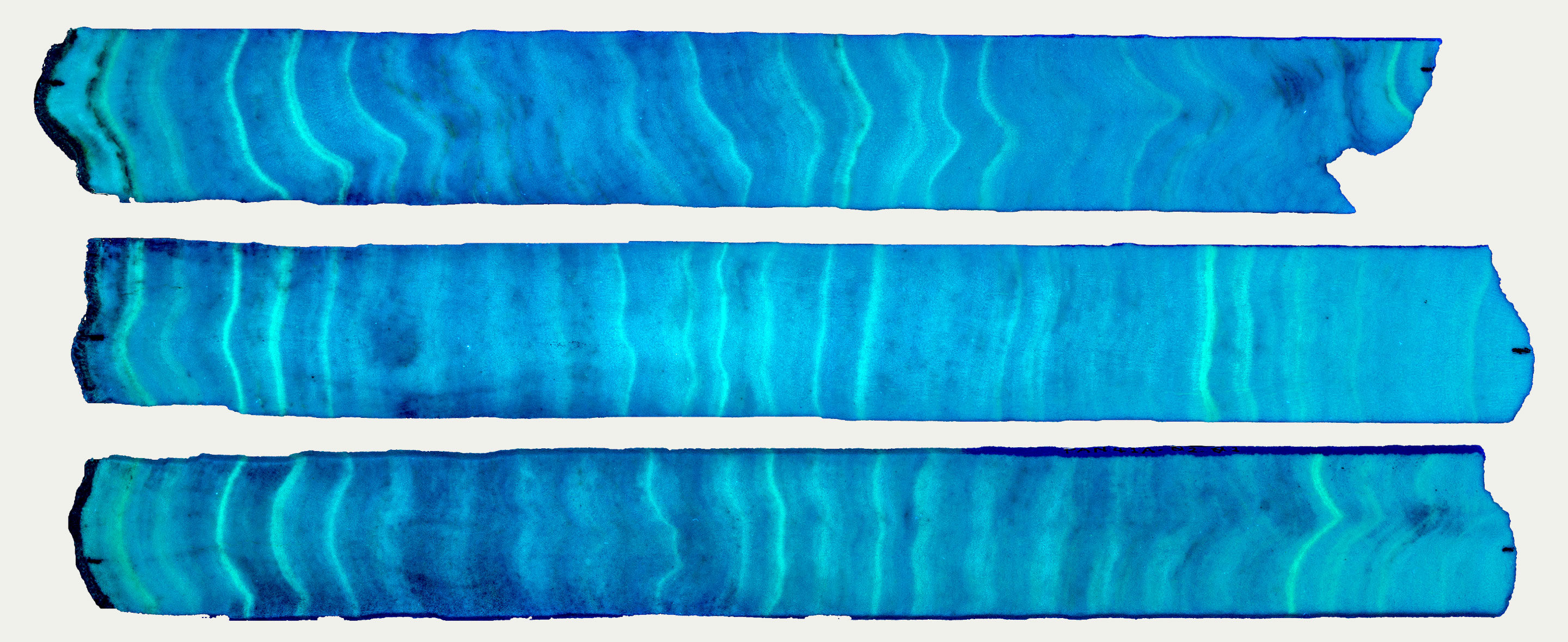 Three core slices demonstrate a complex system of annual rings showing how coral on the reef responded to environmental changes. These samples are illuminated with ultraviolet light, which allows to obtain certain information about their chemical composition.
Three core slices demonstrate a complex system of annual rings showing how coral on the reef responded to environmental changes. These samples are illuminated with ultraviolet light, which allows to obtain certain information about their chemical composition.A team of oceanologists from Woods Hole, including graduate student
Nathaniel Mollic and geologist
Anna Cohen , analyzed samples of modern Porites coral cores taken near Panama, Palau, Taiwan, and the Donsha Atoll in the South China Sea. They placed all the cores in the computed tomography apparatus, a special X-ray device capable of uncovering the details of growth and density changes inside the coral.
By comparing these records from coral cores with water samples taken at each of the sites, scientists have shown that the high acidity of the ocean in past epochs led to the appearance of certain structural anomalies. Corals in more acidic waters grow at about the same speed, but the structure of such corals turns out to be quite different - gaps appear in them, similar to bubbles in pancake dough. This is because after dissolving in water, carbon dioxide combines with free carbonate ions. As a result, there are fewer ions left to coral polyps, and they cannot produce as much calcium carbonate as they need.
Over time, this deficiency leads to the appearance of thinner and porous coral skeletons. “We are, in fact, seeing voids and bubbles inside,” said a
team geochemist to
Weif Guo . Such fragile skeletons are more likely to crumble as a result of storms and shock waves - and this, in turn, threatens other life forms on the reef, including algae that grow food for corals, and fish, whose food depends on them.
Modeling the future of the ocean
Such observations of coral cores fill gaps in knowledge of planetary and ocean dynamics, as well as help researchers predict how future stresses will affect reefs. Researchers at Woods Hole, comparing core data from the predicted increase in ocean acidity due to climate change, concluded that coral skeletal densities around the world by 2100 are likely to decrease by 20%. This prediction emphasizes the susceptibility of future reefs to physical damage.
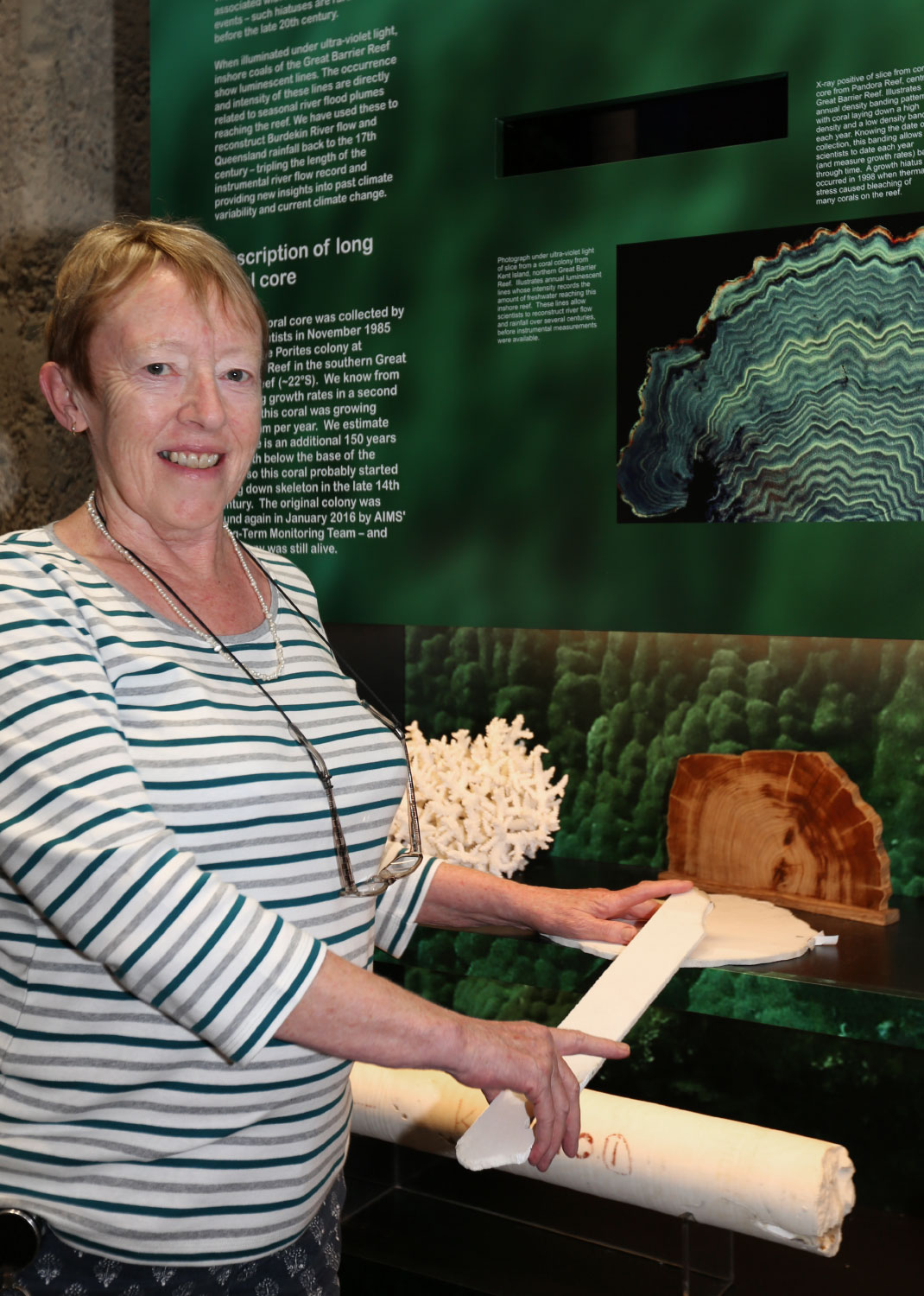 Janice Lowe
Janice LoweMoreover, long-term records stored in coral cores show how quickly reefs grow and adapt to pollution and ocean warming — this is especially important given the current similar trends. “We need historical records of the behavior of the reefs, the changes that took place and their reactions to these changes. This gives us a better understanding of what we may encounter, ”said Webb. “It’s amazing how much we can do by linking all these records together.”
The accumulated knowledge already helps researchers to correct predictive models of the global climate, which, according to Low, will help develop strategies for reef conservation. “Global climate models are not perfect - they are constantly adjusting. Coral records provide evidence from the past that may be useful to these models. ”
A significant part of research funding is spent on documenting the ecology of modern reefs, and there is very little left to test their past. But in order to make accurate assessments of the history and current state of the oceans, Webb, Guo and others believe, it will be necessary to take more coral cores in order to cover a longer period of time. “With a larger collection, you don’t have to base your reasoning on the example of a single coral,” said Guo. “You can tell the story more confidently.”
Ivankov's long-standing goal is to contribute to this unfolding story. After his motorboat - already loaded with samples from the reef - climbs back to Tara, he places the core segments on the deck and lays it on the desktop to dry. After arriving at the port, dozens of cores collected by Ivankov from various places in the Pacific will be sent to the French National Center for Scientific Research and the Monaco Science Center.
Using data obtained from these cores, researchers will collect a detailed portrait of the ocean ecosystem and the interaction of its components. “We collect samples of the entire environment of the colony,” said Ivankov. “Corals, water, fish — we take everything and make up the big picture.” For millennia, corals, cell by cell, have postponed all the evidence for the health and changes of living systems. Now the fate of these systems can give us the ability to decipher the hidden records contained in these skeletons.